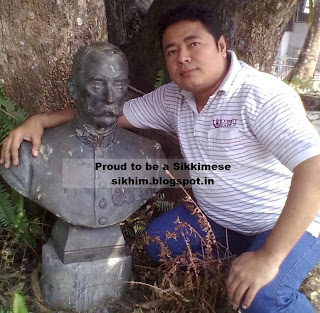I had heard from old folks that there used to be a statue of JC White at the exact place where Jawaharlal Nehru’s statue is present today at Ridge Park near White Hall, Gangtok. Later on, during the early 70s, the statue was removed and replaced with the statue of the first Prime Minister of India. JC White’s statue had gone missing until it was again found and kept at Smile Land, near Ranipool. My fantasy about JC White grew with each passing day and I just wanted to know more about his persona.
John Claude White, a British engineer was sent to Sikkim in 1887 and he handled the situation at the Sikkim–Tibet front peacefully. A year later he was again sent to Sikkim as an Assistant Political Officer with the British Expeditionary Force. With the defeat of the Tibetans during the 1888-89 conflicts, the power of control towards the small Himalayan kingdom of Sikkim came under British rule.
A new post of Political Officer of Sikkim was created, thus making John Claude White, an administrative head of the land of Sikkim. Prior to his visit to Sikkim, the small Himalayan kingdom lacked many basic modern government arrangements. He was supposed to develop and make possible stays for the British men to whom Sikkim was highly important with its considered location. In order to stake authority over the State of Sikkim, the then Chogyal was exiled from Gangtok making White the overall In-charge of the State.
White in his book Sikkim and Bhutan: 21 Years on the North-East Frontier 1887-1908 writes, “one of the first things to be done after his arrival in Sikkim was to build a house, the site for which was found in the midst of the jungles around Gangtok”. White’s residence then called Residency (now Raj Bhawan) was completed after 18 months of hard work and difficulties. Here too lies an interesting story that the Residency was built higher than the Chogyal’s Palace, which could be to show the higher influence White had over Thutob Namgyal, the then Chogyal of Sikkim.
The Residency when completed was a major attraction for the Sikkimese people and people would request White to visit their houses and wander around. It was this home Anna Balikci–Denzongpa in her article “The British Residency in the Himalayan State of Sikkim: A heritage building restored to its former glory published in Bulletin of Tibetology mentions Sir Basil Gould, a Political Officer who wrote in his memoirs “The Jewel in the Lotus” as the most attractive middle-sized in the whole of India.
She further writes, “White is well remembered in Sikkim for having established an administration along with a simple form of law and justice. He built roads, bridges, and bungalows, as well as the first schools and hospitals. Sikkim prior to the late 18th century was the hunter and food gatherer writes JR Subba in his book Evaluation of Man and the Modern Society in Sikkim.

It was only after the last decade of the 1890s that JC White initiated the settlement of its own people and the Nepalese people from Nepal to increase the food production of the Sikkim State. Those settlers cleared the forests for food production and even raised state funds from taxation.
Those people were also used as manual labours for trade. The British policy of settlement was opposed by the closed ones of the Chogyal but White and his men promoted the settlement. He believed in permanent settlement of the population which could help the state of Sikkim raise revenues.
Towards the end of the 1890s, the Political Officer for Sikkim wrote in his diary about the fantastic goods trade outcome in the trade through Sikkim to Tibet for British India. The diary extract of the 16th January 1898 states, "The trade for December is very good, amounting to Rs 3, 41,290. This includes a consignment of gold worth Rs. 16,800- the finest that has been sent in for some years."
In Hong Tran’s Chogyal’s Sikkim: Tax, Land & Clan Policies Political Officer it is mentioned JC White with his British Land Resettlement Program marked the turning point for land ownership in Sikkim. White had carried out the land settlement without the prior concern of the Chogyal who was then detained in Kalimpong. It was the Chogyal’s koshag (council of 12 Lhopo representatives) whom White had brought into his plan.
The outcome of the British Land Settlement showed monasteries would not have any owned lands as stated in past royal deeds of grants. The monasteries were only authorized to “receive gifts and donations of certain villages or blocks, over which they were given religious authority”. The monasteries “did not possess much land”.
Along with the Nepalese, the merchants from India were also invited to Sikkim to do trading. Messrs Dulichand Sri Lall of Gangtok came to Sikkim in 1887 at the request of the then Political Officer JC White Esqr, C.I.E (Sikkim State Archives, Land Revenue, file 48, Enquiry about debts in Sikkim, 27/v/1912) { Lamas, Shamans, and Ancestors: Village Religion in Sikkim- Anna Balikci}

No comments:
Post a Comment